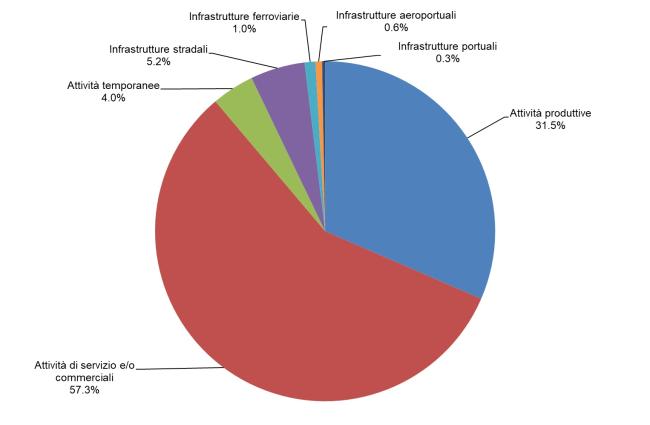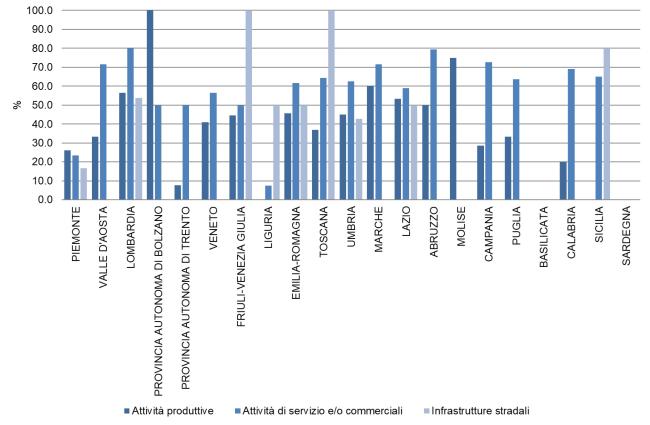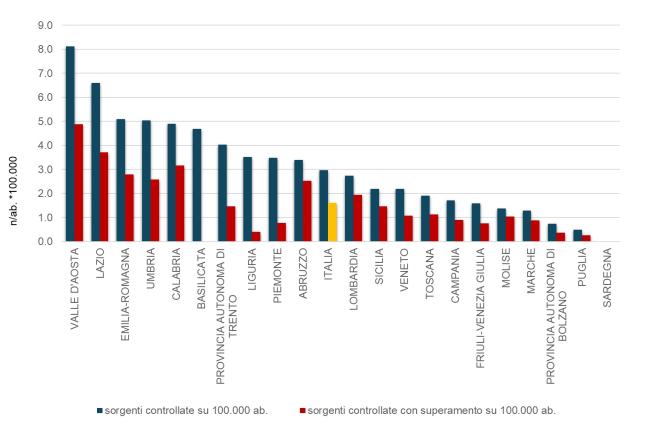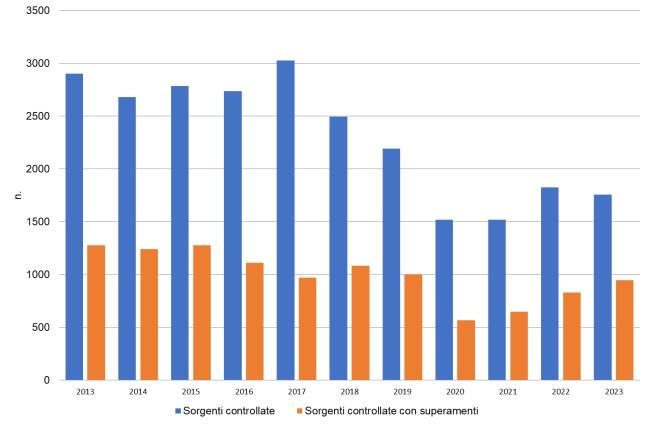Panel 1
Gabriele Bellabarba, Francesca Sacchetti
Noise generated by transportation, industries, and other human activities is one of the main environmental problems and can cause various disturbances to the population. To limit noise pollution and regulate noise sources, national noise regulations (LQ 447/95 and its implementing decrees) have established limit values for different types of sources. These limits are divided into those for the outdoor environment (absolute emission and immission limits), based on municipal acoustic zoning, and limits for the interior of residential buildings (differential immission limits).
This indicator describes the monitoring activities conducted by ARPA/APPA through measurements to verify compliance with the legal limits, both outdoors and indoors, distinguishing among different types of sources (industrial activities, service and/or commercial activities, construction activities and temporary events, road, rail, airport, and port infrastructure). In 2023, as in previous years, the most frequently monitored sources were service and/or commercial activities (57.3% of all monitored sources), followed by industrial activities (31.5%). Among transport infrastructures, which account for 7.1% of monitored sources, roads were the most frequently controlled (5.2%).
The indicator highlights which noise sources are most frequently monitored by ARPA/APPA and the extent of non-compliance, by calculating the percentage of monitored sources that exceeded the legal limits at least once.
To assess, both qualitatively and quantitatively, noise pollution produced by different types of noise sources.
Table C of DPCM 14/11/97 defines absolute immission limits based on six acoustic zoning classes (I - VI) and two reference time periods: daytime (06:00 - 22:00) and nighttime (22:00 - 06:00). The absolute immission limits represent the maximum noise levels allowed from all sources combined in the outdoor environment, measured near receptors. Emission limits, which apply to individual noise sources, follow the same structure but are set 5 dB(A) lower than the immission limits. The decree also establishes differential immission limits, applicable within residential buildings. The differential criterion requires that during the daytime, the difference between ambient noise (including the disturbing source) and residual noise (excluding the disturbing source) must not exceed 5 dB(A), while at night, this difference must not exceed 3 dB(A). However, this criterion does not apply in Class VI areas or to noise from transport infrastructure, non-business-related activities, common building services, and fixed installations inside buildings (limited to the noise caused within the same building). In municipalities without an approved Acoustic Zoning Plan, the limits set by DPCM 1 March 1991 temporarily apply. For transport infrastructure, specific decrees establish immission limits within designated buffer zones, while outside these areas, transport infrastructure contributes to the absolute immission limits set by municipal acoustic zoning plans (Table C of DPCM 14/11/1997). As of today, the following decrees have been issued: DM 31/10/97 for airport noise, DPR 18/11/98 No. 459 for railway noise and DPR 30/03/2004 No. 142 for road noise. A decree setting limits for port infrastructure has not yet been issued, meaning that port noise is currently regulated by municipal acoustic zoning classifications.
Panel 2
-
I dati raccolti sono relativi unicamente alle attività di controllo effettuate dalle ARPA/APPA attraverso misurazioni fonometriche.
-
Data quality assessment
ARPA/APPA (Agenzie Regionali e delle Province Autonome per la Protezione dell'Ambiente)
ISTAT (Istituto Nazionale di Statistica)
The data used for the development of the indicator are sourced from the Noise Observatory database, which is maintained by ARPA/APPA representatives and is publicly accessible at: https://agentifisici.isprambiente.it/osservatoriorumore_public/home.php.
Nazionale, Regionale (19/20)
2000-2003; 2006-2023
Indicator assessment
The indicator shows the percentage distribution of monitored noise sources across different types (activities/infrastructure). It calculates the percentage of sources exceeding legal limits as the ratio of non-compliant sources to the total monitored sources, categorized by type. The indicator also reports the number of monitored sources per 100,000 inhabitants.
In 2023, ARPA/APPA monitored 1,755 noise sources (Table 1), of which 1,626 were investigated following citizen complaints. 53.9% of the monitored sources exceeded legal noise limits at least once, confirming that noise pollution remains a significant environmental issue (Figure 4). On a national scale (Figure 3), 3 sources were monitored per 100,000 inhabitants. Of these, 1.6 sources per 100,000 inhabitants exceeded legal limits, slightly higher than in 2022 (1.4 sources per 100,000 inhabitants).
In 2023, the percentage of sources exceeding legal limits was 53.9%, significantly higher than in 2022 (+8.5 percentage points) and previous years (42.7% in 2021, 37.4% in 2020, 45.7% in 2019, 43.5% in 2018, 32.1% in 2017, 40.6% in 2016, 45.9% in 2015, and 46.3% in 2014) (Figure 4). The number of monitored sources per 100,000 inhabitants in 2023 was 3, comparable to 2022 (3.1) but higher than 2021 and 2020 (2.6), though lower than 2019 (3.7), 2018 (4.2), and 2017 (4.6).
Data
Table 1: Number of Controlled Sources by Region/Autonomous Province
ISPRA elaboration on ARPA/APPA data
Table 2: Percentage of Controlled Sources Exceeding Limit Values (2023)
ISPRA elaboration of ARPA/APPA data




In 2023, as in previous years, service and/or commercial activities remained the most frequently monitored sources, accounting for 57.3%, followed by production activities (31.5%). Among transport infrastructures, which represent 7.1% of the monitored sources, roads were the most frequently checked (5.2% of the total) (Figure 1).
Control activities are mainly carried out following reports or complaints from citizens, representing 92.6% of the monitored sources globally in 2023 (1,626 in total). Service and/or commercial activities also show the highest percentage of regulatory limit exceedances, reaching 61.8%, followed by temporary activities (56.3%) and road infrastructure (51.6%). Significant exceedances are also observed in production activities (41.4%) (Table 2 - Figure 2).
In 2023, 3 sources were monitored per 100,000 inhabitants, and 1.6 per 100,000 inhabitants exceeded noise limits. Regions above the national average in monitored sources per 100,000 inhabitants: Valle d'Aosta (8.1), Lazio (6.6), Emilia-Romagna (5.1), Umbria (5.0), Calabria (4.9), Basilicata (4.7), Trento Province (4.0), Liguria (3.5), Piedmont (3.5), and Abruzzo (3.4). Regions below the national average: Puglia (0.5), Bolzano (0.7), Marche (1.3), Molise (1.4), Friuli-Venezia Giulia (1.6), Campania (1.7) and Tuscany (1.9) (Figure 3). Data for Sardinia were not available for 2023.